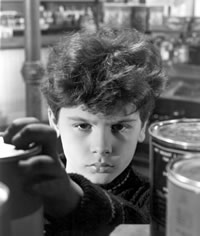Two films that were made with war as unusual backdrops for their narratives were Joseph Losey’s 1948 ‘Boy with Green Hair’, and ten years later, an adaptation of Joyce Cary’s 1944 book, ‘The Horse’s Mouth’.
I first saw ‘The Boy with Green Hair’ as a child and it impressed me for its individualist and political stance. Where I grew up, conformity was not especially the norm, but diversity of ethnicities and intellectualism was. So the kid wakes up one day with green hair, it wasn’t the tragedy of being left an orphan from war. ‘The realization about his parents and the work helping the orphans makes Peter turn very serious, and he is further troubled when he overhears the adults around him talking about the world preparing for another war.’
Joseph Losey was a brilliant ‘filmmaker in exile’ for most of his long career. He was a target for the House Un-American Activities Committee and fled to London to pursue his work in peace. This film was one of his more idealistic and fantastical pieces critiquing governmental (American, Russian, British, French and Chines) policies, ‘couched in terms of fantasy and fable.’Â
The writer Dan Callahan aptly describes the film’s main arc:Â
‘The Boy with Green Hair was an allegory about war and intolerance produced by Dore Schary, a cornball fellow who liked to make little “message†pictures. Many of Schary’s other productions have dated, but The Boy with Green Hair survives well, though it takes a bit too much on its shoulders. It’s an extreme attack on conformity, staunchly anti-war and anti-nuclear. Whilst Fritz Lang undoubtedly influenced his handling of mob scenes, Losey differs from Lang in his volatile identification with his characters. The scene that sticks in this respectable debut is the one where Dean Stockwell, such a touchingly serious child, is forced to give up his individuality, his green hair, in order to please the people of the small town he lives in. Though restrained, the scene is almost tragic, and Losey puts all of his energy behind it. Already he was showing his talent for emotional collisions that cut to the bone without caution.’
The Harvard Film Series has a great offering of classic and current films.
Another tour de force on individuality, Joyce Cary depicted his character Gulley Jimson in The Horse’s Mouth, as an anarchist, drawing on ‘pre-war bohemian life, and is notably sharp on the mundane realities of survival on the breadline, in the vein of Orwell’s social reportage.’ In fact, George Orwell recommended Cary’s earlier novels to the ‘Liberal Book Club’. Cary’s themes in most of his books centered on freedom and liberty, qualities being threatened during WWII.
Directed by Ronald Neame, Alec Guinness portrays the lead character Jimson, loosely patterned by Cary after his friend the poet Dylan Thomas.  Guinness constructs a prankster’s paradise for a wily painter who resorts to subterfuge and lies to feed his obsession; art as life. I read the book after seeing the film in the early 80’s and it remains a favorite, for both laughs and inspiration.
Â
Bruce Eder, from a 2002 Criterion review:
‘Here, unusually, the paintings really do matter. They’re not copies of well-known classics, as in most artist biopics—they were executed by John Bratby, a leading member of the group of English provincial realists who came to be known, rather unfortunately, as the “Kitchen Sink†school. In truth, Bratby would be better described as an expressionist, in view of his vigorous sculpting of paint, even if his preferred subject matter was often domestic. But in The Horse’s Mouth he lends his talent to the tradition of English artists, from William Blake to Stanley Spencer, who wanted to connect the visionary with the vulgar; this is surely what Bratby, Neame, and Guinness do magnificently in the film’s moments of epiphany. Gulley contemplating his sinewy impasto foot by candlelight, or first seeing the wall that will bear his mural masterpiece—these are rare moments when we actually feel something of the artist’s imagination. And in terms of the film’s prescience it is worth noting that Bratby temporarily gave up painting and wrote a novel called ‘Breakdown’ in 1960, because his work had become unfashionable as American Abstract Expressionism swept the world. It’s tempting to feel that life here was imitating art.’
Brad Leithauser says: ‘His is not the calculated stoicism or liberated detachment of the born philosopher. Rather, it’s the sangfroid of someone who must check his emotions because their fervor continually threatens to undo him. Gulley is forever having to squelch his rage. His is the simmering calm of a man who feels a fire roaring underneath him.Â
… it seems the one burning hottest and longest is a conviction that he is destined, as an uncompromisingly innovative artist, to remain an unappreciated soul in his lifetime. Although he shrugs off his neglect with a witty mordancy (“Walls have been my salvation…. Walls and losing my teeth young, which prevented me from biting bus conductors and other idealistsâ€), he carries within him, as he wanders the streets of London, an affronted notion of his own civic inconsequence.
Joyce Cary once wrote of his most famous creation, “Jimson, as an original artist, is always going over the top into No Man’s Land, and knows that he will probably get nothing for his pains and enterprise but a bee-swarm of bullets, death in frustration, and an unmarked grave. He makes a joke of life because he dare not take it seriously.’
Â
The Criterion Collection, an offshoot of Janus Films, Â distributes consumer versions of classic and contemporary films.

